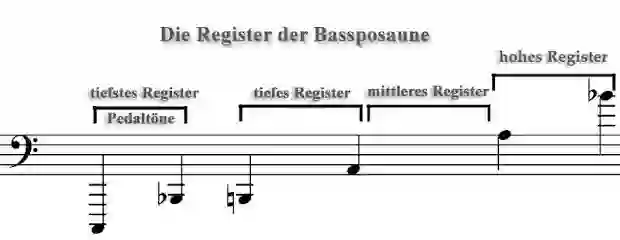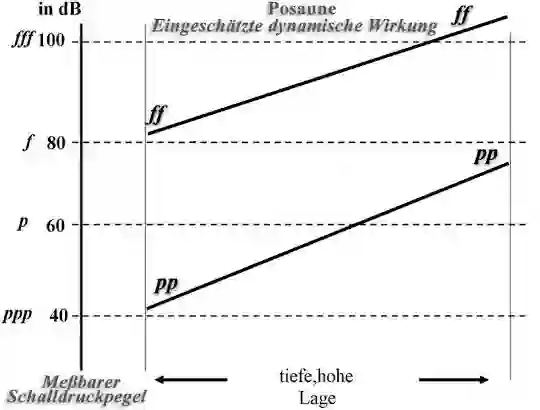Sound charakter of the Trombone - Philipp Dangas
Bass trombone register table
Since the reed of the tenor bass trombone has a slightly wider bore than the reed of the tenor trombone, the sound of the tenor bass trombone is fuller and darker than the sound of the tenor trombone and softer in the high notes, and the bass also responds a little more powerfully. The tenor bass trombone has the widest scale of any wind instrument. Of the bass trombone pedal tones, the first 4 can be played by everyone, the others only by very good players.
As part of the „symphonic world music“
The bass trombone can be a main instrument in the realization of the sound. In any case, the bass trombone contributes to the "impact" of the sound character.
[Music by Shostakovich]
Download size: 135 kilobytes
Table summary of the sound character of the bass trombone
The table below lists the bass trombone registers and tones briefly described. The high register becomes the middle register and the low register and the deepest register described.
Dynamic effect of the trombone
Sheet music for the dynamic table of the tromboneThe dynamic table indicates the strength levels of the musical dynamics. In addition to the sound pressure scale measured in decibels [dB], the degrees of strength of musical dynamics are given on the left, which can be understood as "objective" degrees.
The graph drawn to the right of the dB scale should be noted. It shows the estimated dynamic effect over the entire tonal range of the instrument. The dynamic effect (volume) as judged (perceived) by the listener.
Here is an example: In the low register of the trumpet, the dynamic range between pianissimo [pp] 46 decibels [dB] and fortissimo [ff] 82 decibels [dB] = 36 decibels [dB]. In the high register, the range is 8 decibels [dB]. The estimated values can deviate more or less from the "objective" ones.
In principle, the deviations differ from instrument to instrument. The "objective" degrees of intensity piano pianissimo [ppp]= 40 decibels [dB], p=60 decibels [dB] etc. enable the composer to predict the dynamic effects of different instruments that are sounding simultaneously.
Table summary of trombone dynamic range
The achievable dynamic range of the trombone as brass instrument shows the following table shown. The span is the difference between the fortissimo and the Pianissimo in the same pitch.

A large representation of the register table of a bass trombone
- high register
- Penetrating and very strong
- middle register
- Solid and strong
- low register
- Strong, heavy and full-sounding
- lowest register
- Very dark, very massive

The dynamic table of a trombone
Internal search function
| Name | Value | Delete |
|---|